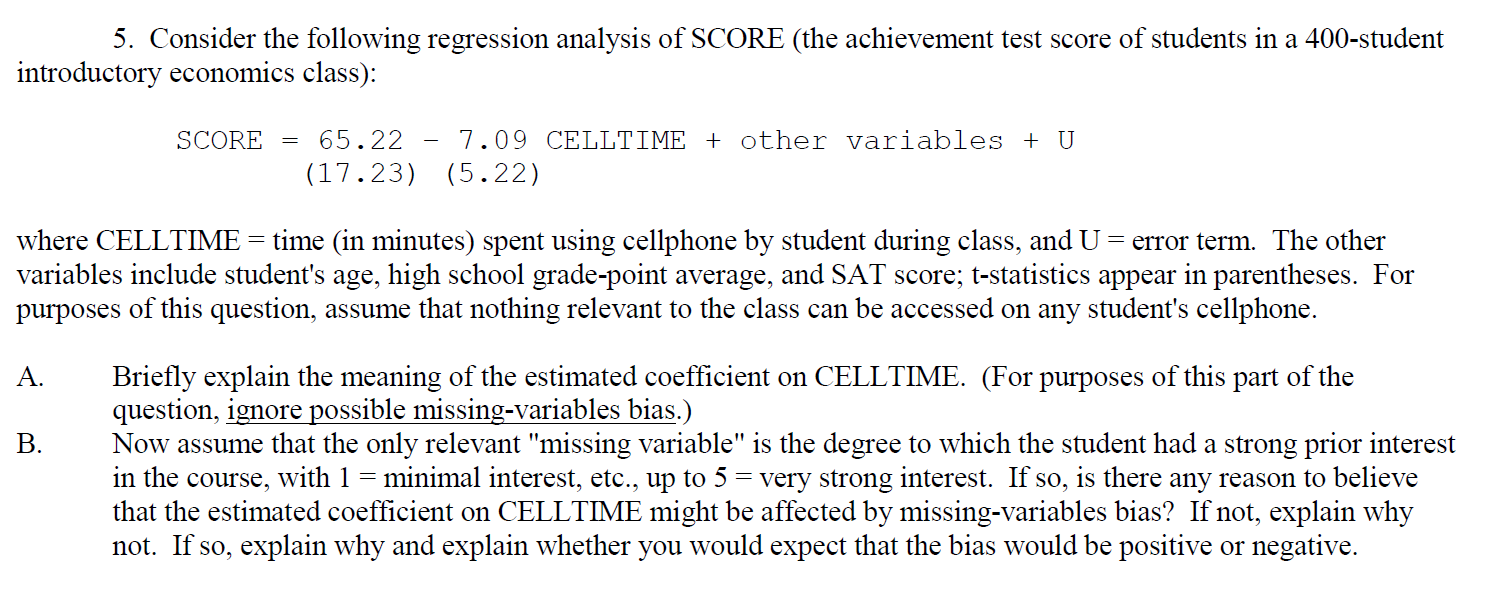5. Consider the following regression analysis of SCORE (the achievement test score of students in a 400-student introductory economics class): SCORE 65.22 7.09 CELLTIME + other variables + U (17.23) (5.22) where CELLTIME = time (in minutes) spent using cellphone by student during class, and U variables include student's age, high school grade-point average, and SAT score; t-statistics appear in parentheses. For purposes of this question, assume that nothing relevant to the class can be accessed on any student's cellphone. = error term. The other Briefly explain the meaning of the estimated coefficient on CELLTIME. (For purposes of this part of the question, ignore possible missing-variables bias.) Now assume that the only relevant "missing variable" is the degree to which the student had a strong prior interest in the course, with 1 = that the estimated coefficient on CELLTIME might be affected by missing-variables bias? If not, explain why not. If so, explain why and explain whether you would expect that the bias would be positive or negative. A. B. minimal interest, etc., up to 5 = very strong interest. If so, is there any reason to believe
5. Consider the following regression analysis of SCORE (the achievement test score of students in a 400-student introductory economics class): SCORE 65.22 7.09 CELLTIME + other variables + U (17.23) (5.22) where CELLTIME = time (in minutes) spent using cellphone by student during class, and U variables include student's age, high school grade-point average, and SAT score; t-statistics appear in parentheses. For purposes of this question, assume that nothing relevant to the class can be accessed on any student's cellphone. = error term. The other Briefly explain the meaning of the estimated coefficient on CELLTIME. (For purposes of this part of the question, ignore possible missing-variables bias.) Now assume that the only relevant "missing variable" is the degree to which the student had a strong prior interest in the course, with 1 = that the estimated coefficient on CELLTIME might be affected by missing-variables bias? If not, explain why not. If so, explain why and explain whether you would expect that the bias would be positive or negative. A. B. minimal interest, etc., up to 5 = very strong interest. If so, is there any reason to believe
Linear Algebra: A Modern Introduction
4th Edition
ISBN:9781285463247
Author:David Poole
Publisher:David Poole
Chapter7: Distance And Approximation
Section7.3: Least Squares Approximation
Problem 31EQ
Related questions
Question

Transcribed Image Text:5. Consider the following regression analysis of SCORE (the achievement test score of students in a 400-student
introductory economics class):
SCORE
65.22
7.09 CELLTIME + other variables + U
(17.23) (5.22)
where CELLTIME = time (in minutes) spent using cellphone by student during class, and U
variables include student's age, high school grade-point average, and SAT score; t-statistics appear in parentheses. For
purposes of this question, assume that nothing relevant to the class can be accessed on any student's cellphone.
= error term. The other
Briefly explain the meaning of the estimated coefficient on CELLTIME. (For purposes of this part of the
question, ignore possible missing-variables bias.)
Now assume that the only relevant "missing variable" is the degree to which the student had a strong prior interest
in the course, with 1 =
that the estimated coefficient on CELLTIME might be affected by missing-variables bias? If not, explain why
not. If so, explain why and explain whether you would expect that the bias would be positive or negative.
A.
B.
minimal interest, etc., up to 5 = very strong interest. If so, is there any reason to believe
Expert Solution
This question has been solved!
Explore an expertly crafted, step-by-step solution for a thorough understanding of key concepts.
This is a popular solution!
Trending now
This is a popular solution!
Step by step
Solved in 2 steps with 2 images

Recommended textbooks for you

Linear Algebra: A Modern Introduction
Algebra
ISBN:
9781285463247
Author:
David Poole
Publisher:
Cengage Learning

Glencoe Algebra 1, Student Edition, 9780079039897…
Algebra
ISBN:
9780079039897
Author:
Carter
Publisher:
McGraw Hill

Functions and Change: A Modeling Approach to Coll…
Algebra
ISBN:
9781337111348
Author:
Bruce Crauder, Benny Evans, Alan Noell
Publisher:
Cengage Learning

Linear Algebra: A Modern Introduction
Algebra
ISBN:
9781285463247
Author:
David Poole
Publisher:
Cengage Learning

Glencoe Algebra 1, Student Edition, 9780079039897…
Algebra
ISBN:
9780079039897
Author:
Carter
Publisher:
McGraw Hill

Functions and Change: A Modeling Approach to Coll…
Algebra
ISBN:
9781337111348
Author:
Bruce Crauder, Benny Evans, Alan Noell
Publisher:
Cengage Learning